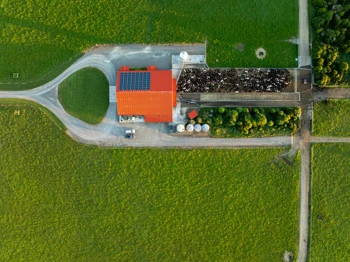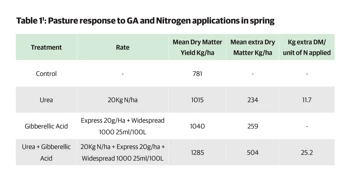News & Advice

Genetically modified crops - do we need a rethink?
By Dr John Caradus
In New Zealand, a genetically modified (GM) organism means any organism where genes or other genetic material have been modified by in vitro techniques (where studies are performed with micro-organisms, cells, or biological molecules outside their normal biological context). This includes New Breeding Technologies such as gene editing.
The aim here is to examine the importance of consumer attitudes towards food produced from GM plants or from animals fed GM feed and consider whether consumer attitudes would reduce the demand and acceptance of food produced by New Zealand pastoral farmers if GM forages were included in animal feed.
New Zealand’s GM history
In New Zealand, genetic modification is regulated under the HSNO Act 1996 administered by the Ministry for the Environment. While research and development on genetic modification of plants is permitted indoors with the appropriate and approved level of containment, there have been few applications over the past 25 years for evaluation of genetically modified plants in outdoor containment trials.
A report published by the New Zealand Productivity Commission 2021 entitled New Zealand firms: Reaching for the frontier⁽¹⁾ concluded that New Zealand’s approach to regulating genetic modification techniques under the HSNO Act 1996 was last reviewed in 2001 and does not reflect technological advances since that time. It boldly recommended that the Government undertake a full review of the regulation of genetic modification, to ensure it is fit for purpose and supports domestic innovation.
The Royal Commission on Genetic Modification⁽²⁾ stated: “Genetic modification has been used freely in New Zealand for more than a decade as a research tool, for medical purposes, and in food ingredients.” Indeed, Food Standards Australia and New Zealand, which is governed by separate legislation, lists on its website 93 foods of plant origin across 10 species, and four foods of microbial origin produced using gene technologies. So, while the New Zealand public can purchase food with GM ingredients, appropriately labelled, it is currently not possible for New Zealand farmers to use GM technologies in food production.

Attitudes towards GM foods and food derived from animals fed GM feed
In many countries animal feed is provided in a total mixed ration containing harvested plants or plant parts (e.g. grain, cottonseed, soybean meal) and much of this is derived from GM crops. Most of the genetically modified traits in these crops are input traits such as herbicide resistance or insect resistance. But increasingly there is a move toward output traits that improve the quality and nutritive value of the plant. Currently the GM traits being sought in New Zealand for forage plants to be consumed by animals are of the latter category. In New Zealand, animal feed is primarily pasture grazed in situ with foods derived from these being dairy or meat products.
A review undertaken in 2016⁽³⁾ concluded that “it is highly unlikely that the introduction of GM plants into New Zealand would have any long-term deleterious effect on perceptions in overseas markets of food products sourced from New Zealand” and is unlikely to affect New Zealand’s image as a tourist destination, and further, there is unlikely to be any premium gained for our food products by remaining GM free. A review⁽⁴⁾ undertaken by the previous Labour government in the early 2000s concluded that “price impacts of GM releases in New Zealand are likely to be lower than those used in the previous modelling and therefore the results for GM organism release scenarios are more likely to be a positive rather than a negative movement in GDP”.
Using genetic modification to mitigate the causes of environmental issues, such as greenhouse gas emissions, nitrogen leaching into waterways, reduced pesticide use, increasing soil carbon, and/or clear health benefits to the consumer may provide a more acceptable balance between perceived risk and benefit. A review of 543 journal articles has shown that public support for the use of GM technologies increases when the potential benefits of the technology are well articulated, there is trust in government regulatory schemes, and media delivers a positive influence that increases belief in science.
Looking to the future
Genetic modification has been widely adopted globally and has shown improved yield, quality and environmental impacts. It also has the potential to provide consumer benefits through improved product quality, nutritive value, and shelf life. Public concern over GM foods is focused on their impacts on human and animal health, environmental safety, labelling and consumer choice, intellectual property rights, ethics, food safety, poverty reduction and environmental conservation.
While there are factions of society that will always be against the use of GM in food production, the evidence from studies attempting to understand market forces and public attitudes is that the use of GM plants in New Zealand for food production is unlikely to have long-term deleterious effects in overseas markets. There is a need for legitimate debate that warrants research effort into providing a clearer impact analysis. In addition to having the political will to use all technologies available to provide solutions to current and future challenges, an informed discussion with major trading partners is required.
In New Zealand, the use of genetic modification is regulated on a case-by-case basis that has been labelled as technocratic and inconsistent with the precautionary principle of regulation. Gene editing that can precisely target changes in genes has been heralded as a game changer, but there are fears it will suffer the same fate as genetic modification, leading to mistrust and suspicion among vocal sectors of society. However, some countries, but not New Zealand, have decided that where gene edits are simply deletions, and the end-product is indistinguishable from products produced through traditional plant breeding, then they do not need to be regulated. From a regulatory viewpoint, consideration is required to focus on regulating the benefit and risk issues associated with the end-products of genetic modification rather than the processes used in their development.
Dr John Caradus is employed by Grasslanz Technology Ltd which has an R&D investment portfolio that includes both genetic modification and gene editing of forages and microbes to provide mitigating solutions to current environmental and animal welfare issues facing New Zealand and other pastoral economies.
References
The full paper on which this article is based can be found here: Caradus, J; (2022) Impacts of growing and utilising genetically modified crops and forages – a New Zealand perspective, New Zealand Journal of Agricultural Research, DOI: 10.1080/00288233.2022.2077380
New Zealand Productivity Commission (2021). New Zealand firms: Reaching for the frontier. Final report. Available at productivity.govt.nz/inquiries/frontier-firms/
The New Zealand Government (2021) Royal Commission on Genetic Modification. Available at https://environment.govt.nz/publications/report-of-the-royal-commission-on-genetic-modification/
Knight JC. 2016. GM crops and damage to country image: much ado about nothing? Acta Hortic. 1124. In: Panis et al. editors. Proc. III International Genetically Modified Organisms in Horticulture Symposium – Past, Present and Future. Pp. 23-31. doi:10.17660/ ActaHortic.2016.1124.4
Review by previous Labour government: https://www.treasury.govt.nz/sites/default/files/2007-09/tr2003-461.pdf




